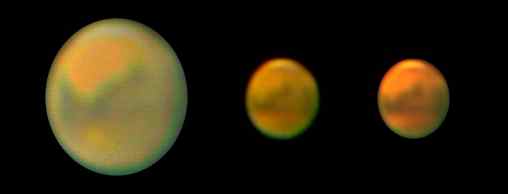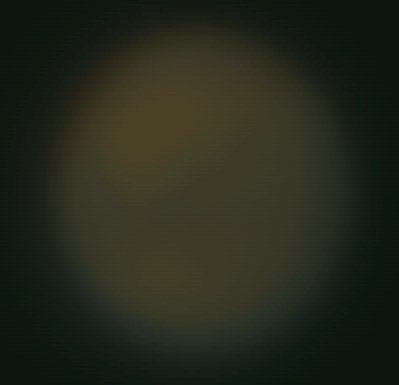MARS

|
Left: Mars as captured at Mount Stromlo Canberra in November 2005
during Mars' close approach. I used the "Tardis" observatory operated by
the Canberra Astronomical Society (CAS). The Tardis is a small tin shed with a
roll-top roof located on top of Mt Stromlo. Inside the small shed is a chunky
14" f/10 SCT. |
These images were captured on the night of 11Nov05 about two weeks after
Mars's closest approach to Earth. I was using a Mintron 62V1P-Ex video camera at
prime focus of the "Tardis" - a 14" Schmidt Cassegrain Telescope (SCT)
situated on Mount Stromlo, Canberra, Australia.
Mars is a tiny object. At prime focus you really have to work to get a high
magnification of the image to get any useful detail, so I found a Powermate (x4) or Barlow
(x2) was essential. In fact I used both at the same time.
When the camera was in the Barlow and the Barlow in the Powermate and the Powermate in
the telescope then I was in business. (Oh yeah, and just for good measure the
camera's digital zoom was sometimes set to x2)
The "seeing" was awful, and the wind was bouncing the scope around. The
atmosphere was so turbulent Mars looked like I was seeing it from the bottom of a fast
flowing river. Around about 2 a.m. the wind died down and then quick as a flash the
seeing steadied quite dramatically. If there was no atmosphere to worry about the
view would have been spectacular, nevertheless on the TV was this large tantalising image
taking up about half the area of the TV screen (see below). It looks all fuzzy I
know but heh! it was 40 million miles away. The image blurs in and out of focus and
bits of Mars would be almost in focus and others would be way out of focus. The
whole planet even wobbled around.
Standing and watching it though, as the image quickly shifted in and out of focus, you
could build up a tantalising impression of some surface details.
The trick with planetary imaging is to capture that impression by "stacking"
hundreds, even thousands, of frames of video and then using computer software (Registax)
to automatically sort them by quality. The higher quality images are then combined
by Registax to give an "average" image. Here is a single frame of raw data
- unprocessed. This is what it looked like "live" on the TV. The
white polar cap is very evident at the top of the globe. The dark albido area
(butterfly shaped) can be seen around the equator and the lighter orange-red areas are
seen in mid-latitudes. What, you were expecting canals?

See other Planets
|

